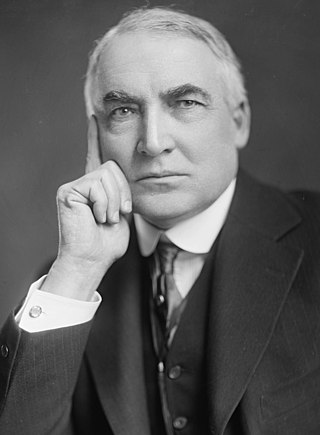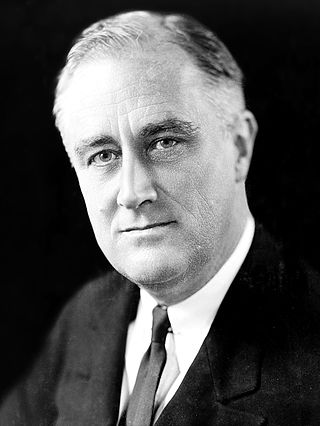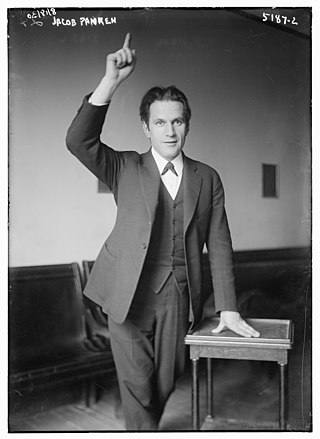| |||||||||||||||||||||
| |||||||||||||||||||||
| |||||||||||||||||||||
The 1921 New York City mayoral election took place on November 8, 1921, resulting in a victory for Democratic Party candidate John Francis Hylan. [1]
| |||||||||||||||||||||
| |||||||||||||||||||||
| |||||||||||||||||||||
| Elections in New York State |
|---|
 |
The 1921 New York City mayoral election took place on November 8, 1921, resulting in a victory for Democratic Party candidate John Francis Hylan. [1]
The major candidates included New York City mayor and Democratic Party candidate John Hylan who stood for re-election, Manhattan borough president and Republican Party candidate Henry Curran, and the Socialist Party candidate Jacob Panken. Hylan was the son of an Irish-Catholic immigrant and affiliated with Tammany Hall machine politics. Curran had run as a coalition candidate for the Republican factions. Panken had run a progressive campaign and gained support from Milwaukee mayor Daniel Hoan, but failed to generate the same level of support as the Socialist candidate from the prior election, Morris Hillquit. [2]
In the primary election for mayor, Henry Curran heavily defeated Fiorello H. La Guardia, president of the board of aldermen.
| 1921 | Party | Manhattan | The Bronx | Brooklyn | Queens | Richmond [Staten Is.] | Total | % |
| John Francis Hylan | Democratic | 261,452 | 118,235 | 260,143 | 87,676 | 22,741 | 750,247 | 64.2% |
| 62.9% | 67.6% | 62.1% | 69.0% | 70.8% | ||||
| Henry H. Curran | Republican - Coalition | 124,253 | 34,919 | 128,259 | 36,415 | 9,000 | 332,846 | 28.5% |
| 29.9% | 20.0% | 30.6% | 28.6% | 28.0% | ||||
| Jacob Panken | Socialist | 28,756 | 21,255 | 29,580 | 2,741 | 275 | 82,607 | 7.1% |
| 6.9% | 12.2% | 7.1% | 2.2% | 0.9% | ||||
| Jerome T. De Hunt | Farmer Labor | 321 | 133 | 395 | 88 | 71 | 1,008 | 0.1% |
| John P. Quinn | Socialist Labor | 316 | 244 | 346 | 123 | 20 | 1,049 | 0.1% |
| George K. Hinds | Prohibition | 375 | 120 | 390 | 111 | 14 | 1,010 | 0.1% |
| TOTAL | 415,473 | 174,906 | 419,113 | 127,154 | 32,121 | 1,168,767 |

Fiorello Henry La Guardia was an American attorney and politician who represented New York in the House of Representatives and served as the 99th Mayor of New York City from 1934 to 1946. He was known for his irascible, energetic, and charismatic personality and diminutive, rotund stature. A socialist member of the Republican Party, La Guardia was frequently cross-endorsed by parties other than his own, especially parties on the left under New York's electoral fusion laws. A panel of 69 scholars in 1993 ranked him first among the ten best mayors in American history.

The 1912 United States presidential election was the 32nd quadrennial presidential election, held on Tuesday, November 5, 1912. Democratic Governor Woodrow Wilson of New Jersey unseated incumbent Republican President William Howard Taft while defeating former President Theodore Roosevelt and Socialist Party nominee Eugene V. Debs.

The 1920 United States presidential election was the 34th quadrennial presidential election, held on Tuesday, November 2, 1920. In the first election held after the end of the First World War and the first election after the ratification of the Nineteenth Amendment, Republican Senator Warren G. Harding of Ohio defeated Democratic Governor James M. Cox of Ohio. It was also the third presidential election in which both major party candidates were registered in the same home state; the others have been in 1860, 1904, 1940, 1944, and 2016.

The 1924 United States presidential election was the 35th quadrennial presidential election, held on Tuesday, November 4, 1924. In a three-way contest, incumbent Republican President Calvin Coolidge won election to a full term. Coolidge was the second vice president to ascend to the presidency and then win a full term.

The 1932 United States presidential election was the 37th quadrennial presidential election, held on Tuesday, November 8, 1932. The election took place against the backdrop of the Great Depression. The incumbent Republican President Herbert Hoover was defeated in a landslide by Democrat Franklin D. Roosevelt, the governor of New York and the vice presidential nominee of the 1920 presidential election. Roosevelt was the first Democrat in 80 years to simultaneously win an outright majority of the electoral college and popular vote, a feat last accomplished by Franklin Pierce in 1852, as well as the first Democrat in 56 years to win a majority of the popular vote, which was last done by Samuel J. Tilden in 1876. Roosevelt was the last sitting governor to be elected president until Bill Clinton in 1992. Hoover became the first incumbent president to lose an election to another term since William Howard Taft in 1912, and the last to do so until Gerald Ford lost 44 years later. The election marked the effective end of the Fourth Party System, which had been dominated by Republicans. It was the first time since 1916 that a Democrat was elected president.

The mayor of New York City is elected in early November every four years, in the year immediately following a United States presidential election year, and takes office at the beginning of the following year. The city, which elects the mayor as its chief executive, consists of the five boroughs, which consolidated to form "Greater" New York on January 1, 1898.
Sewer socialism was an originally pejorative term for the American socialist movement that centered in Milwaukee, Wisconsin, from around 1892 to 1960. The term was coined by Morris Hillquit at the 1932 Milwaukee convention of the Socialist Party of America as a commentary on the Milwaukee socialists and their perpetual boasting about the excellent public sewer system in the city.

The 1982 New York gubernatorial election was held on November 2, 1982, to elect the Governor and Lieutenant Governor of New York. Incumbent Democratic Governor Hugh Carey chose not to run for a third term, which resulted in an open race. Democratic nominee Mario Cuomo, the Lieutenant Governor of New York, narrowly defeated Republican Lewis Lehrman, a banker who ran as a conservative.

The 1934 New York state election was held on November 6, 1934, to elect the governor, the lieutenant governor, the state comptroller, the attorney general, a U.S. Senator, two U.S. Representatives-at-large, the chief judge and two associate judges of the New York Court of Appeals, as well as all members of the New York State Assembly and the New York State Senate.

Irwin Steingut was an American lawyer, businessman and politician. At the time of his death he had served as a member of the New York Assembly longer than anyone in history. Early in his career he teamed with Brooklyn boss John H. McCooey, who turned Brooklyn into a solidly Democratic power base and dominated its politics for a quarter of a century until his death in 1934. Steingut thereafter became the de facto leader of the Brooklyn Democratic Party. Throughout almost all of his legislative career Republicans held a majority in the New York Assembly, and much of that time Steingut was the Minority Leader. In 1935 for the one year the Democrats had the majority, Steingut was Speaker of the Assembly.

The 1917 New York City mayoral election replaced sitting mayor John P. Mitchel, a reform Democrat running on the Fusion Party ticket, with John F. Hylan, the regular Democrat supported by Tammany Hall and William Randolph Hearst.
Labor Party was the name or partial name of a number of United States political parties which were organized during the 1870s and 1880s.

Jacob Panken was an American socialist politician, best remembered for his tenure as a New York municipal judge and frequent candidacies for high elected office on the ticket of the Socialist Party of America.

The 1924 United States presidential election in New York took place on November 4, 1924. All contemporary 48 states were part of the 1924 United States presidential election. Voters chose 45 electors to the Electoral College, which selected the president and vice president.

The 1965 New York City mayoral election occurred on Tuesday, November 2, 1965, with Republican Congressman John Lindsay winning a close plurality victory over the Democratic candidate, New York City Comptroller Abraham Beame.

The 1910 New Jersey gubernatorial election was held on November 8, 1910. Democratic nominee and future President Woodrow Wilson defeated Republican Assemblyman Vivian M. Lewis with 53.93% of the vote. During the campaign, Wilson underwent a political transformation from a symbol of conservative Wall Street reaction into one of the leading members of his party's progressive faction. His victory was widely understood to be the prelude to his campaign for the presidency in 1912.

The 1932 United States presidential election in Wisconsin was held on November 8, 1932 as part of the 1932 United States presidential election. State voters chose 12 electors to the Electoral College, who voted for president and vice president.

The New York City mayoral election of 1933 took place on November 7, 1933 in New York City. Incumbent Democratic Mayor John P. O'Brien, who was elected in a special election after the resignation of Mayor Jimmy Walker, faced Republican Congressman and 1929 mayoral candidate Fiorello La Guardia, and former acting mayor and President of the New York City Board of Aldermen Joseph V. McKee, who became acting mayor after Walker's resignation until the special election, and ran on the Recovery Party line.

The 1934 Wisconsin gubernatorial election was held on November 6, 1934.

The 1925 New York City mayoral election took place on November 3, 1925, resulting in a victory for Democratic Party candidate Jimmy Walker.